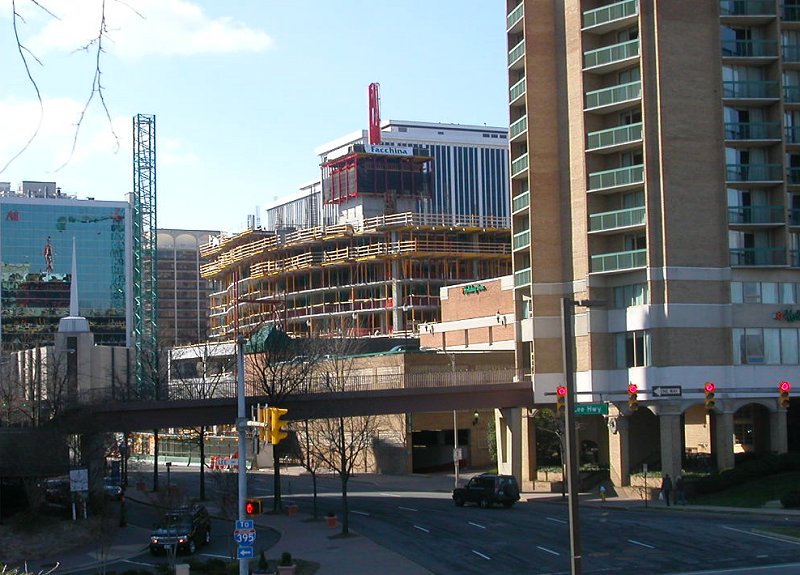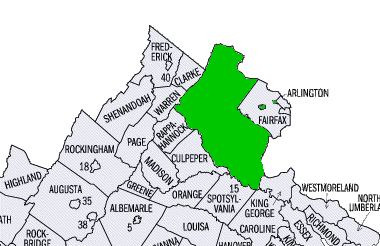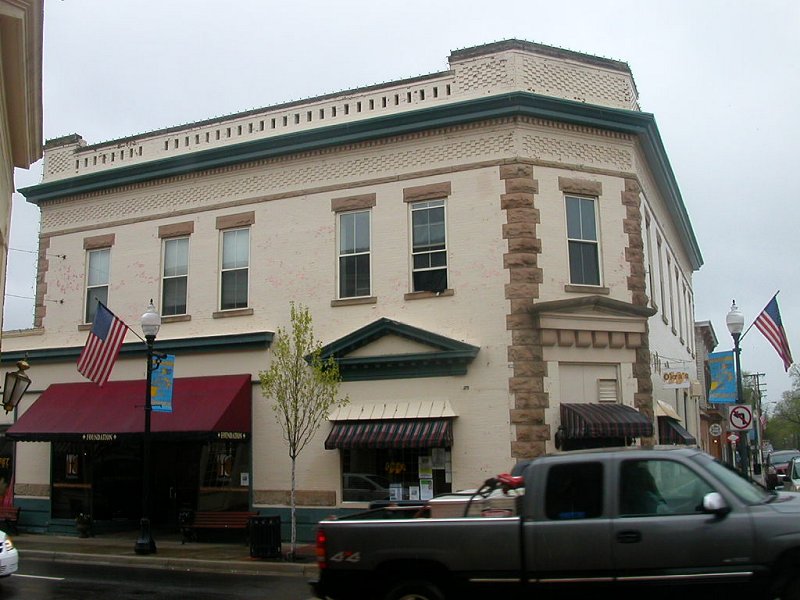
Prince William County - small percentage of commercial real estate in a bedroom county
Source: Prince William County Fiscal Year 2008 – 2012 Projections of General County Revenue
Local governments in NOVA struggle with growth because each new house generates some property taxes, but typically each new house costs the city/county more in services than is generated in taxes. As the population has boomed in NOVA, the cost of providing new schools, fire stations, police, and libraries has climbed as well. (The state pays for most of the roads, but Fairfax and Prince William have passed special bond issues to accelerate road construction.)
A child costs roughly $10-12,000/year to educate in the local school system. If a family sends two kids through 12 years of public schools, then taxpayers will contribute about $250,000 to the education of those two kids. If the two kids came from a $400,000 house, and the tax rate was $1.00/$1,000 assessed value, then in the course of those 12 years the family will pay about $50,000 in property taxes.
Do the math - $50,000 in revenue vs. $250,000 in costs.
Add in the costs of extra services such as fire and police protection, and you can see why low-tax advocates are often strong supporters of "smart growth" proposals... even if the proposals require some government controls on how private property could be developed.
Counties and cities manage to pay their bills. Not every house sends kids to school every year, which is one reason counties encourage development of age-restricted subdivisions such as Heritage Hunt in Gainesville. Few couples over 55 years in age still have children in public schools, so the county might make a "profit" on property taxes from those houses - offsetting the costs of other, children-filled neighborhoods.
Local governments also get revenue from sources other than property taxes on residences. In addition to funding from state and Federal sources, Fairfax County gets 20% of its property taxes from commercial real estate.1 Since office buildings require fewer services - fire stations are still needed, but no kids go to school from an office building - the county may receive more in taxes from non-residential property than the county spends to provide services to that property.

Arlington County is particularly "rich" in commercial real estate, and is a center of jobs in Northern Virginia. The county has an estimated January 2008 population of 206,800, while the county is home to an estimated 205,300 jobs.2 If only Arlington residents were filling those jobs... every man, woman, and child in Arlington would be going to work. Obviously, people living in other Northern Virginia cities/counties (or even across the Potomac River) are working in Arlington County.
Figuratively, Arlington County swells up like a balloon every morning and deflates every evening, as commuters who work in the county come and go to residences in other jurisdictions. All the office buildings accommodating those commuters generate property taxes for Arlington, keeping overall property taxes low in the county - while the commuters generate costs for schools and other services provided by their bedroom communities, requiring higher property taxes in places such as Stafford County.
From a financial perspective, smart growth involves sustainable development, where tax revenue will be equal to or greater than the costs to provide government services. It's "smart" because "dumb growth" is more expensive to support, requiring higher taxes. County/city officials set the property tax rate, Increasing tax revenues through development of commercial property, and reducing the cost to provide government services, creates the opportunity for elected officials to lower property taxes.
There are some obvious opportunities to increase efficiency in providing government services, in order to reduce costs. The standard smart growth answer is to concentrate development to minimize the number of schools, libraries, roads, etc. needed to service the population. Don't scatter houses all over the map, then try to build infrastructure to service sprawled-out subdivisions. It's academic to pontificate that the costs of government services can be reduced if development is clustered in just a few areas.
The process by which development actually can be concentrated... ah, there's the challenge. Assuming that elected officials can snap their fingers and implement controls on growth, and get re-elected, is no more realistic than believing in the Easter Bunny. And don't assume just "evil developers" are standarding in the way of smart growth.
Northern Virginia is a land of freedom and opportunity, where people want to make their own choices regarding personal lifestyles. Politicians do not run for office with a campaign platform "Vote for me, and I'll restrict your options. I'll make sure you won't be able to live in the suburbs, with a white picket fence and a yard. I'll make you live in a dense urban setting, even if you wanted to have a place for the dog to run." Developers know they need to be able to sell what they build. If the customers want houses on quarter-acre lots (a density of just 4 dwelling units/acre), then developers will recognize the demand and try to get government approvals to supply that demand.
Still, we know it's "dumb growth" to continue developing housing far from jobs, and forcing residents to commute through traffic twice a day. It's "dumb growth" to establish zoning districts that are exclusively residential, or exclusively commercial, and thus forcing people to drive to the store as well as to work. It's "dumb growth" to spread houses out in subdivisions so far from each other that only a few people live within a quarter mile (standard walking distance) of any possible bus stop/rail station. In such subdivisions, mass transit is unrealistic.
Smart growth is creating mixed use communities, with transit services so residents will not need a car to commute to work. The model smart growth pattern is to build "town centers" where people walk/bus to not only their jobs, but also to schools, shopping, and recreational areas. In mixed use town centers, housing and shopping and offices are co-located within walking distance - or even within the same building.

To be sure you can articulate the basics of smart growth, read:
There are some people in Northern Virginia with philosophical objections to smart growth, because it relies upon the power of government agencies to shape the development of private property. Others oppose smart growth under the assumption that total development potential will be limited, forcing up the cost of housing and eliminating "affordable housing" in the urban areas.
More-intense opposition to smart growth proposals comes not from "dumb" landowners who never studied geography, but from people who will lose economic opportunity if government steers development away from now-rural areas. In a society based on capitalism, it's reasonable to expect those landowners to fight hard for their opportunity.
So where should the "smart growth" occur? Who will benefit from those land use planning decisions?
If Loudoun, Prince William, Fauquier, and Stafford counties mandate smart growth through zoning decisions and investments in the transportation infrastructure, inevitably some landowners will be "winners" and others will be "losers." Some developers will lose the opportunity to convert rural areas acquired by the acre into subdivisions/retail centers that could be sold by the square foot.
After all, only so much economic growth will occur in Northern Virginia. If development activity is concentrated in a few areas, lots of other areas will remain unaltered by development. If demand is steered to existing developed areas by government agencies through zoning and transportation decisions, the value of raw undeveloped land west of Route 15 will drop. Owners of that raw undeveloped land will not be happy... unless they are one of the wealthy landowners in western Loudoun and Fauquier counties who don't desire to develop, and want to retain their existing way of life.
The Piedmont Environmental Council proposed a "Blueprint for a Better Region" in 2002. It stated the choice clearly: to have smart growth, we must either move jobs out from DC/inner suburbs to the housing on the periphery, or we need more people to live near the job centers. We should grow near existing developed areas, rather than extend the periphery of Northern Virginia further to the west and south.
Ed Risse defines one measure of smart growth success: there a "clear edge" to the area of intense development, beyond which land uses are significantly less developed (parks, forests, farmland). A county that use its zoning classifications to define a clear edge as the urban growth boundary is, in Ed's eyes, a county that is implementing smart growth principles.
Here's an unrealistic scenario, to illustrate the potential of concentrating population within a defined boundary: if all of Fairfax County was developed at the same density as Arlington County (7,2876 people/square mile, according to the 2000 Census), we could fit about 2.9 million people into just Fairfax County. If we moved all current residents out of Fauquier, Loudoun, Prince William County, and Stafford County counties (plus the cities of Fairfax, Falls Church, and Fredericksburg), the population of Fairfax County would double.
If we settled everyone in Fairfax County, it would have a density of about 5,000 people/square mile (significantly less than Arlington today). The crescent of jurisdictions stretching from the Potomac River north of Leesburg to the Potomac River east of Fredericksburg could become a giant green park, totally empty of people, with a clear edge at the boundaries of Fairfax County.

(Low-density development can transform vast amounts of real estate from its original natural conditions, but that's not a real proposal. Smart growth seeks to create livable communities and lower tax burdens, shaping future growth - not displacing people from existing development. No one is advocating that suburbia could be returned to its natural state, though National Geographic has speculated recently on how developed areas would morph over time if people just disappeared.)
Smart growth is not a new idea, of course. There's a reason developers describe new smart growth subdivisions as "traditional neighborhood" projects. Have you figured out yet that most of Northern Virginia communities were "smart growth" areas a century ago?
Small towns such as Vienna, Herndon, Fairfax, Occoquan, Manassas, Leesburg, etc. provided jobs for local residents, or a train for commuting to Alexandria and DC. Workers did not ride horses far to get to work. Residences were close together in the city, with plenty of porches (even second-story porches for sleeping) in the days before air conditioning. People lived above the stores in downtown areas. There were often people on the streets, during work hours and later at night, so fears of anonymous crime were lower than in modern abandoned-after-5:00pm office parks and commercial canyons.

In the countryside, farmers had walk-to-work jobs, though the physical requirements may have been exhausting by today's standards. Recycling was a normal event - even animal manure was recycled as fertilizer. Lifestyles were sustainable with local or regional resources, with minimal need for imported goods.
Smart growthers tend to highlight some traditional values of small communities such as self-reliance, while skipping over other characteristics of life in the old days. Be aware that, from a social perspective, our modern values are not reflected in the "traditional" lifestyles of 100 years ago.
Draining wetlands was described as "land reclamation." In 1912, one legislator reportedly said the rivers of Virginia were the "God-given sewers of the State" while opposing waste control legislation. Efforts to ensure worker safety were not well-defined. Formal education was seen as having limited value, and teachers in public schools were not required to have college training.
When smart growth was the norm, so was social inequality. Northern Virginia was a highly segregated world then, with limited opportunities for those who were not white males. There is nothing inherently wrong with learning from the past, cherrypicking good ideas and discarding outdated ones, but be conscious of your language. Referring to the past as the "good ol' days" may not be appropriate. If you are in a multi-cultural setting and start referencing an era that was not "good" for everyone, don't be surprised to have your consciousness raised.
1. County of Fairfax, Virginia FY 2009 Advertised Budget Plan - Citizen’s Guide To The Budget, p.3, http://www.fairfaxcounty.gov/dmb/advertised/FY2009/citizens_guide.pdf (last checked April 22, 2008)
2. "Arlington County Profile" for 2009 Budget, p.1, http://www.arlingtonva.us/Departments/ManagementAndFinance/budget/fy09proposed/A_Arlington%20County%20Profile%20.pdf (last checked April 22, 2008)